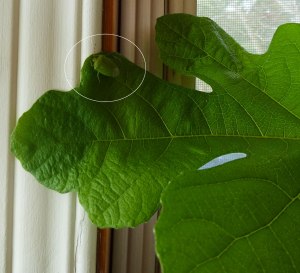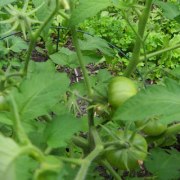The back porch is the closest I can get to a cool greenhouse. It has windows on three sides, and is heated with electric baseboard heaters that are turned down to 40F most of the winter. This makes it a great place to over-winter the fig tree and any remnants of outdoor pots that I can’t bear to toss out in the Fall. It’s also a catch-all for garden remnants that are awaiting further processing. This includes several year’s worth of flax plants and a container of black walnuts (the hulls are another story).
This year, the fig tree started putting out leaves in February, which seems a little early, but so far it seems happy enough and is sporting a little bug that perfectly matches the green of the leaves.
In spite of having two years worth of flax to experiment with, of course I’m planning to plant and harvest some more this year. I suspect that it takes a great deal of raw fibre to produce even a very small amount of linen thread, so the more the better.
The black walnuts are enjoying their second winter in the porch, so it may be time to make a present of them to the local squirrels. I’m always amazed that they are so good at getting at the kernels, a job I do not greatly enjoy doing myself.
Next on the agenda is a trip to the farm to put out a few sap buckets and see if we can make a few litres of maple syrup. It’s fun to get outdoors on a sunny day in March and listen to the patter of the sap droplets in the buckets and poke at the wood fire that we use to boil down the sap. Cold, but fun.











